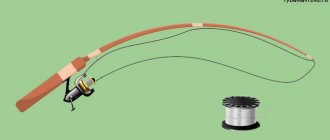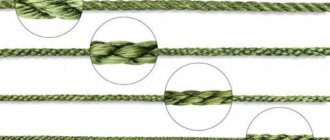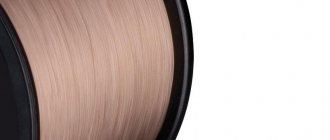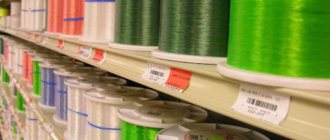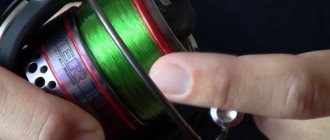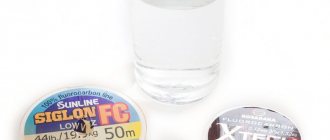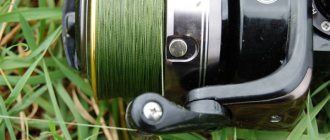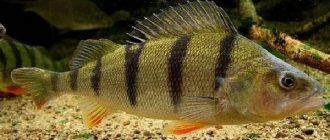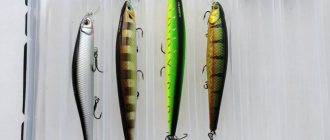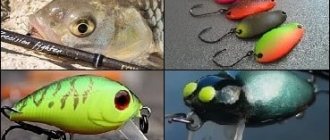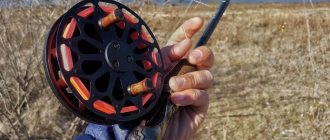| Place | Name | Characteristics in the rating |
| The best monofilament fishing lines for pike |
| 1 | Allvega ZDX | The most wear-resistant in the category |
| 2 | Sneck Magnum | Optimal combination of characteristics and cost |
| 3 | Dragon Elite Pike | The best choice for spinning fishing for trophy pike. Lack of shape memory |
| 4 | Yoshi Onyx Drake Superline XT | High quality monofilament |
| The best braided fishing lines for pike |
| 1 | Quantum XTR Braid | Better tear resistance |
| 2 | SIWEIDA TAIPAN ELITE PE BRAID X8 | The optimum ratio of price and quality |
| 3 | YGK G-soul Upgrade PE X8 | The most reliable cord. Impeccable quality of raw materials |
| The best fluorocarbon fishing lines for pike |
| 1 | Seaguar R18 Fluoro LTD | The optimal choice for fishing in overgrown reservoirs |
| 2 | Sufix Super 21 Fluorocarbon | The most effective disguise |
| 3 | Mikado NIHONTO FLUOROCARBON PRIME | Doesn't twist. Best characteristics for long casting |
When fishing with a spinning rod, the reliability and performance characteristics of the fishing line are important. So, when hunting for pike (especially trophy ones), the strength of the leash, stealth and tear resistance play a huge role. The success of catching a predator depends on the correct choice of fishing line type and parameters.
Our review presents the best fishing lines for pike in three types: monofilament, braided and fluorocarbon. The rating was compiled based on the characteristics of the participants and the responses of anglers who have successful experience using these products in different conditions.
Fluorocarbon
Fluorocarbon (fluorocarbon) fishing lines invented in Japan. They combine the properties of monofilament and braided lines. Like braid, they have low elongation and are resistant to external factors, just like cords have a high price. The similarity with monofilament lies in its low strength and invisibility in water.
According to time of year and weather
Temperature and visibility in the water affect the final choice of fishing line. So, in winter, you should opt for monofilament or fluorocarbon fishing line. They are invisible in icy clear water, are quite durable and do not freeze over, unlike braided wire.
At the same time, fluorocarbon is too harsh for jigs and a balancer, but is optimally suited as a leader material for girders. But as the main thread, you should choose monofilament, which can absorb pike jerks and avoid breakage.
When choosing a fishing line, the seasonality of fishing is also taken into account. Spring time is characterized by a period of predator feeding with a spawning break. And therefore in the spring they put out any fishing line, as long as it fits the dimensions of the expected catch and matches the bait. The color of the fishing line depends on the personal preferences of the angler. For some, a bright thread helps control the wiring, while others consider it too noticeable for a predator. Although during the zhora period the pike attacks everything that catches its eye, and such caution is sometimes excessive.
In summer, the predator does not experience hunger, because the reservoirs are full of fry, and therefore you need to select gear more carefully.
Important! Active fish biting begins in inclement weather. The level of activity is high before a thunderstorm, as well as on cloudy days with little wind and rain.
Select fishing line and bait depending on the reservoir. So, for rivers with intense currents, there is nothing better than sinking wobblers, for which braided or fluorocarbon is used. But in still water, floating structures with which monofilament lines are used achieve greater success.
In autumn, pike activity is at its maximum due to ideal water conditions, as well as preparation for wintering. It is quite justified to use large baits (80-120 mm) with a medium or low degree of immersion. Low water transparency makes it difficult for the fish to distinguish between bait and line, and therefore you can choose thick threads if they do not affect the casting distance.
A different fishing line may be effective on each body of water.
[custom_ads_shortcode3]
Useful video
How to choose a fishing line in the video below:
The choice of fishing line for spinning is fundamental. The outcome of the fishing depends on its strength, sensitivity and visibility. There are three types of fishing line for fishing rods: nylon fishing line, also known as monofilament, monofilament, monofilament fishing line - a common option; braided or braided cord - in second place in terms of frequency of use, it is highly durable; fluorocarbon, fluorocarbon, fluorocarbon fishing line - high-strength fishing line invisible in water.
Rarely used as a main product due to its high cost. You need to choose which fishing line is best for spinning for pike based on a combination of factors: the type of bait used, thickness or diameter, the time of year when fishing will be done, and cost.
To prevent the catch from being lost at the crucial moment, you should choose the right fishing line.
[custom_ads_shortcode3]
I believe - I don't believe
As we have already said, even well-known brands make “inaccuracies” when indicating the diameter and tensile strength. But this is not the main danger for those who buy wicker. The market is full of fakes. There are companies and stores that purchase kilometers of cord on huge reels, and then cut it and package it in “branded” packaging with catchy inscriptions and brands of famous manufacturers.
It is hardly possible even for an experienced fisherman to recognize a fake when purchasing
It remains to take indirect precautions:
- Having bought a high-quality cord once, take a good look at it and buy only this one in the future (unless, of course, you are tempted to experiment);
- ask experienced fishermen which store you should trust more than others;
- be prepared for the fact that the actual breaking load will be one third less than stated on the packaging;
- you need to be especially careful when trying on cheap wicker. You know, a bait lost when it breaks can be more expensive than the entire fishing line;
- When buying fishing line on a reel, look at the cord. Signs of low-quality fishing line - abrasions, adhesions, uneven color;
- At home, when rewinding the braid onto the bobbin, carefully look for the same defects. By law, you have the right to return a defective product within a certain period. In Russia it is two weeks.
Read Top 10 best wobblers for asp fishing and photos
Braided cord
The most popular type of fishing line among anglers. It is made by weaving together several very thin nylon threads. This production method gives the braid much greater strength, many times greater than the breaking characteristics of conventional fishing line. Other positive qualities of this type of fishing line include softness, ease of winding and minimal stretch.
We recommend reading: Basic rules for choosing braid for spinning rods
The main disadvantage of braided fabric is its fragility in frosty weather. Because of this, use at subzero temperatures is not recommended. In the warm season, damage can be caused by the presence of hard or cutting objects at the bottom of the reservoir - stones or shell fragments.
It is also worth remembering that using braid with a spinning rod requires a special coating on the guide rings. Without it, the braided thread may leave marks on the inside of the rings, which will damage the fishing line.
Fluorocarbon
Fishing line based on chemical polymers. It has been used for a long time, but as a leash material. Thanks to its composition, it is very wear-resistant, practically invulnerable, but expensive and breaks quickly, so it is not used as the main one, but for a leash of 1-3 m it is just right.
The main feature of fluorocarbon is invisibility. Its refractive index of light is almost the same as that of water. The fish practically does not see it.
Advantages of fluorocarbon:
Disadvantages of fluorocarbon:
- The same rigidity does not allow making a reliable, strong knot; the fishing line constantly slips out.
- To attach fluorocarbon leashes, special units are needed , but they do not provide a full guarantee.
- Very low breaking load. For this reason, it is not used as the main one. Maybe 0.18-0.2mm in size. for light spinning rods.
Medium-soft MicroTex braided fishing line with a diameter of 0.25 mm is resistant to mechanical damage, almost invisible in water, and does not stretch well. Unwinding 125 m. Breaking load 7.5 kg. Cost - up to 3 USD per skein.
For catching perch, which rarely reaches 1.5–2 kg, or small pike, it is quite justified to use a fishing line with a thickness of 0.16–0.2 mm with a breaking load of 3–5.5 kg, respectively.
Today, there are a lot of new products on sale from fishing line manufacturers that are almost not susceptible to ultraviolet radiation, are resistant to mechanical damage, and do not have a memory effect, so everyone can choose as they wish.
When using braided cords, you need to take into account that they cannot be used at subzero temperatures. The fact is that the woven thread is porous and during fishing water gets between the threads, which when frozen increases in volume and disrupts the structure of the thread. Thus, the choice of fishing line for spinning depends primarily on the fishing conditions and the intended trophy.
The rigid line Jaxon Alaska Feeder with a diameter of 0.3 mm is contrary to all recommendations, but the results when fishing with it are excellent. This year I tried fishing line (0.25 mm in diameter), very good recommendations. If this is not available, ask for a rigid fishing line with a diameter of 0.25–0.3 mm.
Tips for a fisherman: How to make a line for pike fishing - Answers for beginners
Soft line Jaxon Crocodile Spinning with a diameter of 0.25–0.27 mm is more expensive: if I’m not mistaken, up to $10 per package (two skeins).
Medium-soft MicroTex braided fishing line with a diameter of 0.25 mm is resistant to mechanical damage, almost invisible in water, and does not stretch well. Unwinding 125 m. Breaking load 7.5 kg. Cost - up to 3 USD per skein.
Soft CarpPro line with a diameter of 0.2 mm, black. stretches well. Unwinding 100 m. Breaking load 5.5 kg. No memory effect. Cost - 2.5-3 USD per skein.
So, we take a monofilament or braided fishing line with a diameter of 0.18–0.20 mm for catching small fish (up to 3 kg) with light spinners (up to 15 g), and a fishing line with a diameter of 0.25 mm for catching medium fish (up to 5.5 kg ) fish on medium (up to 25–30 g) spoons.
Read about the importance of a leash in the next article by Sergei Zhuravsky.
Read about how to choose the right rod for a beginner spinning fisher here, and a reel here.
Options with a diameter of 0.2 to 0.4 mm are used as the main fishing line for feeder fishing, float fishing and many other types of fishing.
Monoline is used for fishing with feeder, float, spinning and other types of fishing. The main requirements are tensile strength, elasticity (the ability to tie in knots), invisibility (small thickness or camouflage coloring), resistance to environmental influences, and friction resistance. International fishing line standards are developed by the International Game Fishing Association (IGFA).
You can ask a more experienced fisherman for advice. Or you can choose for yourself by first studying the characteristics.
Fishing lines have a number of important parameters, but we will consider only those that we will need later.
The most important characteristic is diameter . On the modern fishing market you can find almost any diameter. However, the bulk are models with a diameter of 0.1 - 0.4 mm. This indicator affects the casting distance (the smaller the diameter, the better its flight characteristics), as well as visibility in the water (the smaller the diameter, the more inconspicuous the line). The smaller the diameter, the less the line takes up space on the spool.
Another important parameter is unwinding , that is, length. The most common unwindings are 100, 150 and 300 meters. There are also unwinding lengths of 50, 75, 110, 135, 200 and 250 meters. Which one to choose - everyone decides for themselves, choosing the optimal one for their gear and conditions.
The rod structure is selected depending on the type of bait. For wobblers, fast and medium fishing rods are used, for spinners - medium and slow. There are no special tips for choosing a telescopic or plug-in type of fishing rod. Everyone chooses based on their preferences and convenience.
Prologue
Pike was not the first fish that I caught many years ago when I began to master spinning. And not the second, and not even the tenth. From the theory I knew from books, I, of course, knew that pike teeth pose a very serious threat to the fishing line, and therefore it is necessary to put a leash, but I fished purely in Russian, i.e. according to the principle “until the thunder strikes...”.
First, I found out what the retail chain was offering. In stores there were two types of leashes: half-meter long, twisted from two steel wires, with winding rings at the ends, and slightly shorter “double-knee” ones.
Somehow, from the very beginning, I don’t know why, neither one nor the other inspired confidence. In addition, they were thoroughly coated with grease, which made these leashes unpleasant to the touch.
And I began to look for an alternative.
They turned out to be short, 7-8 centimeters, but, surprisingly, over the course of several years there were only a couple of times when this length turned out to be insufficient - and the pike finally got to the fishing line with its teeth, cutting it. In later years, I note that it happened several times that the pike bit off the bait twice during a fishing trip, and the leash was longer.
Such a high efficiency of a short leash was due to the fact that at the turn of the 80s I fished mainly with hardware, and primarily with spinners. But a typical oscillating spoon is itself long, and during a characteristic bite, when a pike grabs the bait across, contact of the teeth with the fishing line is practically impossible.
Only if the spinner is compact, like a “Spoon”, or the pike is large. However, I didn’t catch large pike at that time, so the question of lengthening the leash was irrelevant.
But then I began to slowly master jig fishing. And problems immediately emerged: on two fishing trips in a row there were offensive cuts. It became clear that such “chain mail” for fishing with “foam rubber” and its analogues were a bit short, it was necessary to look for an alternative again...
The further course was predictable: the leash requires wire, and the easiest way to find it is in the Cultural Goods store, in the Musical Instruments department. Half the counter there was occupied by a variety of strings - from balalaika strings to those that were used on instruments, the name of which didn’t mean much to me at the time. I found out which ones were cheaper - they turned out to be balalaika ones. The problem is mostly solved.
I made leashes 12-15 centimeters long from strings. There is only one thing that I had not decided on at that time - what kind of strings are optimal as raw materials for leashes. I used those that were currently on hand.
At the base, one of my roommates turned out to be the then Moscow champion in spinning, Alexander Kovalenko. From him I learned several interesting things, including about leashes.
Yes - a string, yes - a guitar string, specifically - No. 2. It is convenient and reliable - both in general and for jig fishing in particular.
And Kovalenko was just a representative of the jig school; he actively caught the then relatively little known foam rubber fish.
Since that time, I have made almost all of my leashes from guitar strings - “twos”. The string leash has now become so popular that, I estimate, at least half of the metal “B” guitar strings sold in Moscow are used not for their intended purpose, but by us, fishermen.
"Soft surrogates" of the first wave
It turns out that I have been using leads made from strings in general for 25 years, and purposefully made from guitar “twos” for more than 15. Time is more than enough to identify all their relative pros and cons. But first, I’ll say not about guitar leads, but about some of those that were considered, or even continue to be considered, as an alternative to them. Let's start with a couple of practical examples.
1996, competitions near Saratov. The FireLine cord had just appeared. If you remember your first impression of it, then most likely it was something like this: the new cord is something armored and invulnerable. So one of our team members, Vladislav R., confident in this, decided to use the 20-gauge Fire as material for leashes.
He fished it out competently, but when it seemed that the “crocodile” was about to be in the boat, a subtle movement of his head followed - and the leash was cut in half. Vlad was so upset that he was no longer able to catch at full strength until the finish line and brought “zero”.
If he had taken that pike, we would have been first, but as it is, we barely managed to grab third place.
2000, “pilot” Russian Championship near Krasnodar. The namesake of our previous hero, Vladislav N., used Kevlar leashes, which were very strongly recommended to him by an acquaintance who worked in a fishing store. After all, body armor is made from Kevlar and many other things that are heavy-duty and impenetrable.
Line color
The visibility of the equipment for fish depends on this parameter. The pike notices the bait from a great distance, often due to ambushes, and once it has already begun its attack, nothing will confuse it. Therefore, the color of the fishing line does not play a decisive role. However, for the best fishing results, you should follow a few tips:
- Transparent monofilament line or gray braided cord are considered universal and least noticeable.
- The color of the fishing line is selected according to the type of reservoir and its bottom. Fishing in clear water involves using neutral colors - gray or dark green. For fishing on sand spits, choose the appropriate tone - sandy. If the fishing spot has a muddy bottom or is overgrown with dense underwater vegetation, it is better to use dark swamp shades.
- It is better not to fish with fishing line of bright flashy colors.
- The success of a particular color depends on various factors - such as the season, lighting, the color background of the reservoir and the bottom. Having gear with fishing line of different spectra and experimenting, changing them alternately, you can choose the one suitable for each specific fishing.
- The color of the fishing line directly affects its strength. The most difficult color in this regard is black. Therefore, when deciding to use black lines, you should try not to save money, but to purchase high-quality products from well-known manufacturers that have proven themselves among fellow hobbyists.
Recommended reading: Choosing and using the right vibrotail when fishing for pike
